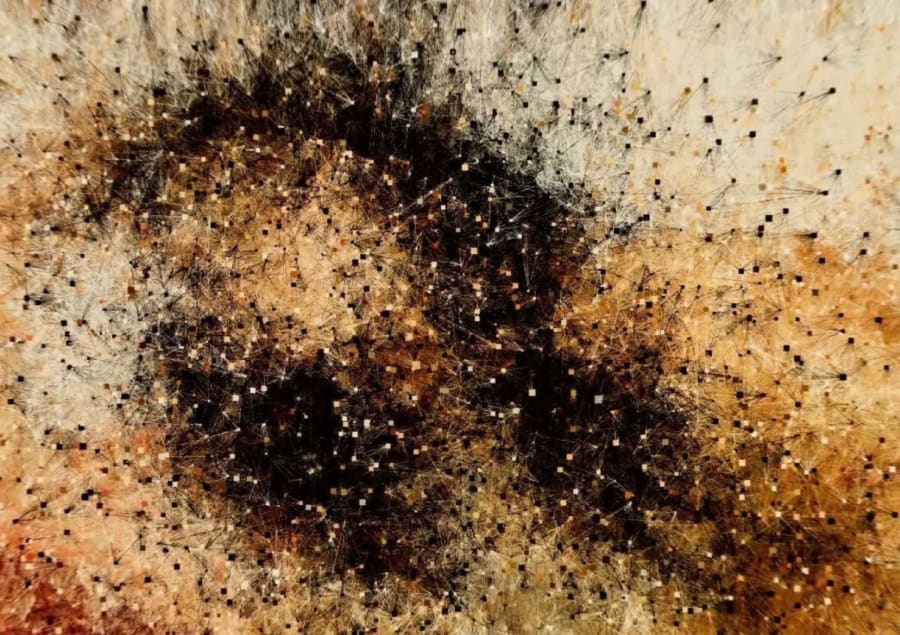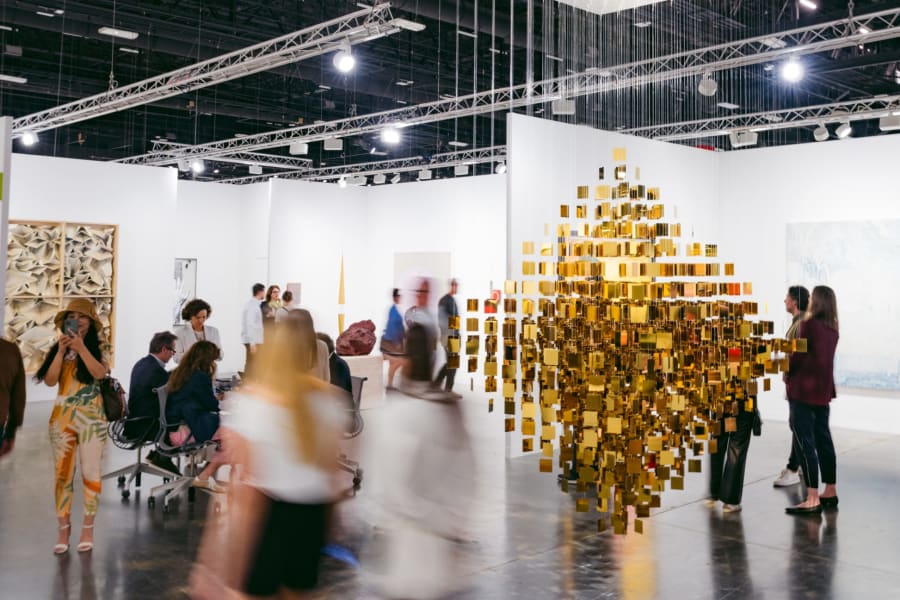At first glance, Sanford Biggers’s new artist edition for the Art Basel Shop might seem lightweight compared to other work he’s known for – pieces like Laocoön (2015), the giant balloon figure of Fat Albert made to seem like he is struggling to breathe, or Oracle (2021), his 15,000-pound bronze sculpture of a seated Zeus wearing a composite of African masks. For his capsule collection, Biggers applies cartoonish bubble clouds to hoodies, totes, mirrors, and tape; and for a jewelry range made in collaboration with DoDo, talismanic cloud charms dangle from choker necklaces. But, the artist explains, these clouds bear more weight than first appears.
You’ve connected your cloud motif to your time doing graffiti in Los Angeles in the 1980s.
Between seventh and tenth grade, I took a high degree of interest in my art classes, but I was also DJing with friends and breakdancing. Rap, which was nascent at the time, was like a living culture. We started doing a lot of graffiti, sharing our tag books with each other, then going out and doing burners [elaborate, masterpiece graffiti works] and pieces in alleys and train tracks in West and South Central LA. One [rail] yard was totally invisible, so you could actually be there during the day. I did one of my first pieces there. And interestingly enough, the background had clouds. That was one of the first entry points into using clouds. It was a stock effect that graffiti artists would use back in the day.
Being in Japan in the 1990s impacted you too, right?
I was there teaching English, a very standard, conventional job. But at night I was unleashed into the mizu-shōbai, the Japanese nightlife. I found artists and creatives and bohemians who were also looking at society and saying, ʻThere’s another way.ʼ We were all listening to the same music; it was real underground culture.
Did something happen with clouds while you were there?
I consider the cloud pieces part of a series I call ‘Unsui’. Unsui is a Japanese word that describes a monk who has finished training but is sort of wandering around and going to different temples and monasteries to find a place to live or practice. And sometimes that’s just part of the lifestyle – being nomadic. I went back to Japan to do a residency in the early 2000s, and did a big performance at a Sōtō Zen temple. I was melting down fat gold chains and rings and all this different metallic jewelry that I got in the Bronx and Harlem, and I took it over to Japan and worked with an artisan to make these prayer bowls out of it. The performance was a big prayer bowl concert. After that, the head monk asked me if I wanted to come see this rare ceremony, which had not been done at the temple for over 70 years. There was a young monk coming in from another town, and that’s when I learned the word ʻunsui.ʼ
Can you describe the ceremony?
There were around 150 people and I was the only foreigner there. You’d expect this to be a very conservative, regimented type of ceremony with a lot of pomp and circumstance – and I think it was supposed to be – but the problem was, it hadn’t happened in this temple for many years, so there was no one there who had ever done it. I was sitting with the monks in the back room, and these guys were looking through old books and manuscripts, sipping whiskey and smoking cigarettes, trying to figure out how to do the ceremony. And I think that’s the metaphor: even this deeply spiritual moment had a lot of humor and confusion and improvisation in it.
You use this syncretic strategy in your practice. What are the roots of that?
The funny thing is, people say to me, ‘Oh, wow, it must have been really difficult for you to make the decision to become an artist.’ My dad became a neurosurgeon coming from the Jim Crow South. I think that was far more difficult. He and his contemporaries, who were engineers, doctors, and lawyers, came from the Second or even First Great Migration, going from the South to various parts of the US. All of them were Renaissance people, because they had to know everything. They had to know the beginning, middle, and end of all the books they were reading, whether it be literature, science, or mathematics, just to compete, just to get noticed. He influenced me, my brother and sister, to take that approach in whatever we did. And he was very romantic about how he viewed the brain. He viewed the brain as the universe, and that the universe is boundless.
I’m interested in your use of a cartoonish cumulus shape for the collection, and for the ʻUnsuiʼ works broadly. Though there’s a sparse clarity to the form, it’s also an almost stereotypical representation of a cloud – am I sensing a bit of subversion or humor here?
I’ve used various types of clouds throughout my practice – stratus and cirrus clouds, and some I think are akin to the kind of cloud work you see on Tibetan and Japanese mandalas and tankas. But the most recent clouds in my ‘Unsui’ works, yes, are almost comical, very light and humorous. In comparison to some other works, like my marble pieces, or some of my quilt pieces, the works where the content is sometimes a bit heavier, this is purposefully subversive. It needs to be seen and understood within the larger oeuvre.
What do clouds mean to you in the current moment, as this new capsule collection is coming out?
Right now, the cloud experience that keeps coming to mind is when youʼre taking off in a plane and getting through the cloud layer, or youʼre coming back down to land. When the clouds are all around you, you have an extended moment for reset. You don’t know what’s below you. You don’t know what’s above you. But you have this sort of obvious mass, this mist, that’s full of potential.
By the way, what was your tag when you did graffiti?
Busy B.
Rob Goyanes is a writer from Miami, Florida, whose work has appeared in The Paris Review, Frieze, Los Angeles Times, and elsewhere. He also runs Goyo Editorial, a shop for strategic communications and text editing. He lives in Los Angeles, California.
Sanford Biggers’s artist edition is available for purchase at the Art Basel Shop, located at the Grand Ballroom, during Art Basel Miami Beach opening hours.
Sanford Biggers is represented by Marianne Boesky Gallery, New York and Aspen; MASSIMODECARLO, Milan and London; Monique Meloche Gallery, Chicago; David Castillo Gallery, Miami; and Baldwin Gallery, Aspen.
Art Basel Miami Beach runs December 5 – 7, 2025. Discover all galleries participating in Art Basel Miami Beach's 2025 here.
Caption for header image: Portrait of Sanford Biggers. Photo: Matthew Morrocco.
Published on November 26, 2025.


